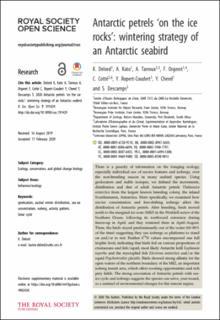| dc.contributor.author | Delord, Karine | |
| dc.contributor.author | Kato, A. | |
| dc.contributor.author | Tarroux, Arnaud | |
| dc.contributor.author | Orgeret, F. | |
| dc.contributor.author | Cotté, C. | |
| dc.contributor.author | Ropert-Coudert, Yan | |
| dc.contributor.author | Cherel, Y. | |
| dc.contributor.author | Descamps, Sebastien | |
| dc.date.accessioned | 2020-05-19T12:32:43Z | |
| dc.date.available | 2020-05-19T12:32:43Z | |
| dc.date.created | 2020-04-22T12:08:52Z | |
| dc.date.issued | 2020 | |
| dc.identifier.issn | 2054-5703 | |
| dc.identifier.uri | https://hdl.handle.net/11250/2654988 | |
| dc.description.abstract | There is a paucity of information on the foraging ecology, especially individual use of sea-ice features and icebergs, over the non-breeding season in many seabird species. Using geolocators and stable isotopes, we defined the movements, distribution and diet of adult Antarctic petrels Thalassoica antarctica from the largest known breeding colony, the inland Svarthamaren, Antarctica. More specifically, we examined how sea-ice concentration and free-drifting icebergs affect the distribution of Antarctic petrels. After breeding, birds moved north to the marginal ice zone (MIZ) in theWeddell sector of the Southern Ocean, following its northward extension during freeze-up in April, and they wintered there in April–August. There, the birds stayed predominantly out of the water (60–80% of the time) suggesting they use icebergs as platforms to stand on and/or to rest. Feather δ15N values encompassed one full trophic level, indicating that birds fed on various proportions of crustaceans and fish/squid, most likely Antarctic krill Euphausia superba and the myctophid fish Electrona antarctica and/or the squid Psychroteuthis glacialis. Birds showed strong affinity for the open waters of the northern boundary of the MIZ, an important iceberg transit area, which offers roosting opportunities and Rich prey fields. The strong association of Antarctic petrels with seaice cycle and icebergs suggests the species can serve, year-round, as a sentinel of environmental changes for this remote region. | en_US |
| dc.language.iso | eng | en_US |
| dc.rights | Navngivelse 4.0 Internasjonal | * |
| dc.rights.uri | http://creativecommons.org/licenses/by/4.0/deed.no | * |
| dc.subject | Ecology | en_US |
| dc.subject | conservation | en_US |
| dc.subject | global change biology | en_US |
| dc.subject | behaviour geolocation | en_US |
| dc.subject | austral winter distribution | en_US |
| dc.subject | sea-ice concentration | en_US |
| dc.subject | iceberg | en_US |
| dc.subject | activity pattern | en_US |
| dc.subject | lunar cycle | en_US |
| dc.title | Antarctic petrels ‘on the ice rocks’: wintering strategy of an Antarctic seabird | en_US |
| dc.type | Peer reviewed | en_US |
| dc.type | Journal article | en_US |
| dc.description.version | publishedVersion | en_US |
| dc.rights.holder | © 2020 The Authors. | en_US |
| dc.subject.nsi | VDP::Zoologiske og botaniske fag: 480 | en_US |
| dc.subject.nsi | VDP::Zoology and botany: 480 | en_US |
| dc.source.volume | 7 | en_US |
| dc.source.journal | Royal Society Open Science | en_US |
| dc.identifier.doi | 10.1098/rsos.191429 | |
| dc.identifier.cristin | 1807501 | |
| dc.relation.project | Norges forskningsråd: NARE Programme | en_US |
| dc.relation.project | Andre: BNP Paribas Foundation | en_US |
| cristin.ispublished | true | |
| cristin.fulltext | original | |
| cristin.qualitycode | 1 | |

